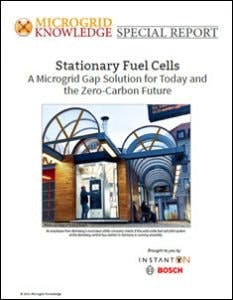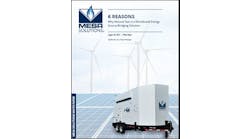In a new special report series, we explore microgrid gap solutions for those who need immediate reliability while their microgrid is being built. The first installment introduces the role stationary fuel cells play as a microgrid gap solution.
Download the full report.
Homeowners and businesses around the United States increasingly understand the value of microgrids to ensure a reliable supply of electricity, manage energy costs and operate sustainably. Unfortunately, many can’t afford to wait the 12-24 months for a microgrid to be permitted, installed and brought online at their property. And the solar and battery storage systems that are popular for many homes and small businesses in sunny areas with ample roof space or land don’t provide the amount of power needed to operate in many scenarios, such as high-power demand data centers and industrial facilities.
These customers need a microgrid gap solution to fill three key gaps: the power gap; the fit gap and the sustainability gap
The ideal microgrid gap solution is cleaner than a diesel generator today and enables the transition to net zero, can quickly serve on-site power requirements and can later be integrated into a microgrid. This staged approach not only gives customers immediate power reliability, but also can lead to lower capital and operating expenses.
Modular solid oxide fuel cells are a microgrid gap solution for all three gaps. Off-grid fuel cells can be installed in a matter of weeks and can be configured for any project size and energy demand. They are able to run on readily available natural gas today and serve as an ideal technology to transition to the energy future. They can mix low- or zero-carbon hydrogen or renewable biogas into the fuel mix as supplies become more available, ultimately becoming zero-carbon energy generators.
Brought to you by Microgrid Knowledge in partnership with Instant On and Robert Bosch, a leading global supplier of technology and services, this special report helps microgrid developers and other service professionals — such as plumbers, engineering, procurement and construction (EPC) contractors and distributed energy resource (DER) installers — learn the basics about fuel cells as well as:
- How they serve as a microgrid gap solution.
- How they act as a permanent, hydrogen fuel-ready transition to the future.
- How they offer an opportunity for industry professionals to provide new products and services to customers.
The definitive guide to fuel cells for microgrid developers
In the coming weeks, this special report series will explore the following topics:
- What solid oxide fuel cells are and how novel DERs will plug into the IoT landscape of tomorrow.
- How fuel cells offer a transition to — and a product for — the energy future.
- How the business model for fuel cells is a win for customers and installers.
- Opportunities for microgrid developers and other providers to grow customers and services with fuel cells.
Download the full report “Stationary Fuel Cells: A Microgrid Gap Solution for Today and the Zero-Carbon Future,” courtesy of Instant On and Robert Bosch to learn more.







